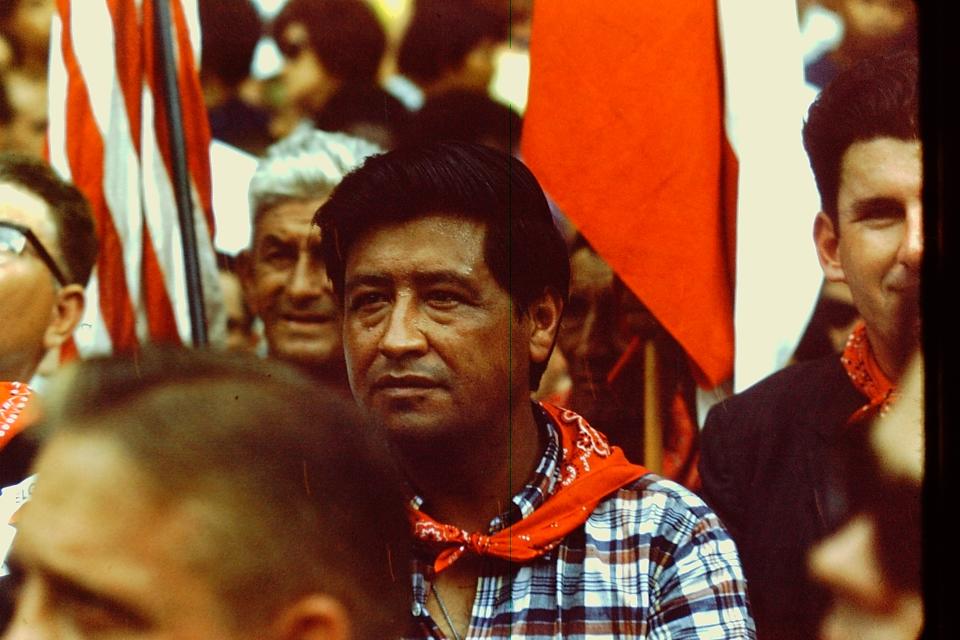Cesar Chavez Day is observed on March 31. How was he connected to Arizona?
- Oops!Something went wrong.Please try again later.
- Oops!Something went wrong.Please try again later.
- Oops!Something went wrong.Please try again later.
The farmworker organizer and civil rights leader whose life and work are honored with a federal commemorative holiday is known as Cesar Chavez. March 31 is Cesar Chavez Day.
But his real name was Cesario Chavez, a fact not commonly known, said Rafael Martinez, a professor of Southwest Borderlands at Arizona State University.
Chavez, born nearly 100 years ago in San Luis, Arizona, was named after his grandfather. But he dropped the last two letters of his first name when he started grade school because Cesar sounded more "American" than Cesario, Martinez said.
Chavez grew up during a time of segregation in the Southwest, and people of color, including Black people and Mexican American people, attended schools separate from white people, Martinez said.
"That was very common for Mexicano community members in Arizona, not just along the borderlands but as far up here as Phoenix, where during segregation time most folks, by the time they reached grade school, they Americanized their names or used the name that was easier to pronounce for the grade school teachers, who were primarily white at that time," Martinez said.
Who was Cesar Chavez?
Chavez was a former farm laborer who gained national and international recognition in the 1960s and 1970s as a labor organizer and civil rights leader who followed the militant nonviolence traditions of Mahatma Gandhi and Rev. Martin Luther King Jr.
After losing land during the Great Depression, Chavez's family became migrant farmworkers. They followed harvests in Arizona before moving to California. Chavez attended more than 30 schools by the time he left school in eighth grade to work in the fields, Martinez said.
Chavez served two years in the U.S. Navy during World War II, Martinez said.

Chavez began organizing in California in the early 1950s, first with the Community Service Organization and then with the National Farmworkers Association, which later joined forces with the United Farm Workers of America. In 1965, the National Farmworkers Association voted to join a grape strike spearheaded by Filipino farmworkers in Delano, California. The strike and national grape boycott evolved into a civil rights movement.
Chavez was raised Roman Catholic and fasted numerous times to call attention to the plight of farmworkers. During one of the longest, a 25-day water-only fast in 1968, Chavez lost 35 pounds and endangered his life, according to the UFW.
Cesar Chavez's ties to Arizona
Chavez was born on March 31, 1927, in San Luis, a small town near Yuma in the southwest corner of Arizona on the U.S. border with Mexico. He also died in the same area on April 23, 1993, at the age of 66.
On May 11, 1972, Chavez started a water-only fast at the Santa Rita Hall in Phoenix to protest House Bill 2134. The bill outlawed many of the common tactics used by Chavez and farmworkers to demand better working conditions. One of the bill's provisions allowed growers to get restraining orders to prohibit farm workers from striking during harvest periods.
Chavez began the fast immediately after then-Gov. Jack Williams signed the legislation. Williams signed the law just 45 minutes after the Legislature passed it, indicating the pressure put on lawmakers from powerful business groups to limit organizing by farmworkers, Martinez said.
During his fast, Chavez was visited by several prominent civil rights leaders and politicians, including Coretta Scott King, wife of Martin Luther King Jr., and U.S. Sen. George McGovern, a Democrat from South Dakota who was running for president, Martinez said.
Chavez's fast lasted 24 days. On the day he ended it, hundreds of people, including 19-year-old Joseph P. Kennedy II, son of Robert F. Kennedy, joined him at a Mass.
The Santa Rita Hall still stands. It's located in a neighborhood of modest houses near Buckeye Road and 7th Street near Chase Field, where the Arizona Diamondbacks play, in downtown Phoenix.
The popular Latino and immigrant rights slogan "Si Se Puede" was coined during the fast at Santa Rita Hall. Workers doubted their ability to take on conservative Arizona's powerful businesses and political forces, saying, "No se puede." Dolores Huerta, co-founder of the farmworker movement, responded, "Si se puede" — yes, it can be done.
Obama proclaims federal commemorative holiday
In 2014, President Barack Obama declared March 31 Cesar Chavez Day, a federal commemorative holiday. He urged Americans to observe the day with educational programs and public service that honor his legacy.
"On Cesar Chavez Day, we celebrate one of America's greatest champions for social justice. Raised into the life of a migrant farm worker, he toiled alongside men, women and children who performed daily, backbreaking labor for meager pay and in deplorable conditions," Obama said. "Cesar Chavez devoted his life to correcting these injustices, to reminding us that every job has dignity, every life has value, and everyone — no matter who you are, what you look like, or where you come from — should have the chance to get ahead."
In Arizona, many schools are closed on April 1 in observance of Cesar Chavez Day. In Phoenix, city offices also will be closed on April 1.
Reach the reporter at daniel.gonzalez@arizonarepublic.com.
This article originally appeared on Arizona Republic: Cesar Chavez Day is March 31. How was he connected to Arizona?

